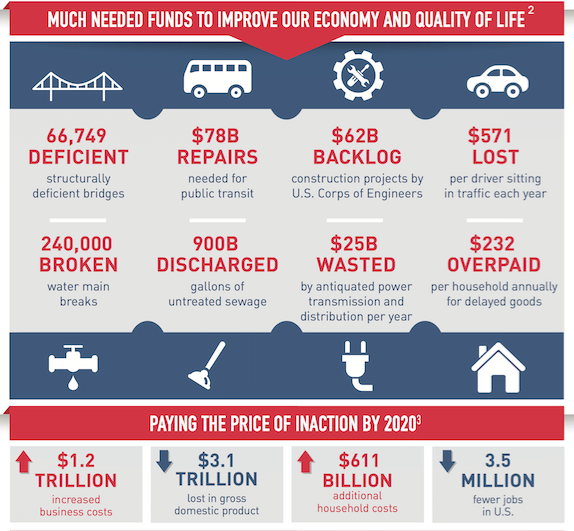
16 May Bridging the Gap Together: A New Model to Modernize U.S. Infrastructure
We have an extraordinary opportunity in America—to confront the pressure being placed on our nation’s roads, water systems, ports, airports, and energy grid with available private capital. This report establishes the framework to unite projects that need funding with private capital ready to invest in a transparent system that allocates risks and resources to the public’s benefits.
America is a nation of innovators—we are inspiring new industries through interconnected devices, commercializing suborbital space flight, and advancing cures to life-threatening diseases. Yet if we hope to foster the next generation of entrepreneurs that can push our economy forward and maintain our quality of life, we must invest in our infrastructure. Wise infrastructure investments would create millions of jobs, maintain the health, safety, and security of our communities, and set our nation on track for decades of greater prosperity.
This is a choice between action and paralysis. Not making decisions today has serious consequences for tomorrow. We are already confronting prior mistakes as our infrastructure today is failing us. We are living at risk: driving every day on eroding roadways, questioning whether our water is really safe to drink, and sending our children off to schools built for our parents’ generation. The problem is growing worse. It shouldn’t be this way in a country that for so long has led and inspired the world.
The Challenge We Face: Short-Term Focus Fuels Mounting Liabilities
The investments made 50 to 100 years ago are nearing the end of their useful life. We have no coordinated vision or plan for their replacement. And public agencies have struggled to maintain existing assets or plan for their replacement, let alone to make the investments necessary to support future population growth and economic needs.
The price tag to adequately prepare America for the future is hefty—likely requiring trillions of dollars to upgrade, modernize, and expand our infrastructure. Long-term needs—operations and maintenance, repair, expansion and modernization of infrastructure systems—are too often ignored in favor of a focus on short-term costs.
There are many competing demands for public resources—healthcare, public pensions, and existing debt—that are expected to overwhelm public budgets. If we are to meet our nation’s future needs and preserve our American quality of life, the public sector cannot continue to cover the cost and absorb the risk of our degrading infrastructure alone. We have to act before lasting damage is done to our economy and the next infrastructure-related failure consumes another American community.
The Solution Is Clear: Long-Term Outlook Compels New Model, Delivers More Infrastructure
There is another way. The private sector stands ready to partner and assist—bringing an appetite for risk, necessary capital, and valuable expertise. Investors with hundreds of billions of dollars to deploy are actively seeking infrastructure projects to support.
Unfortunately, there are a number of barriers preventing the investment of private capital into U.S. infrastructure projects. As a result, America is leaving dollars on the table as capital flows to more receptive shores.
Together the public and private sectors can establish a new model for infrastructure investment that confronts risk and captures value over a project’s full life-cycle—propelling America’s infrastructure into a modern, technologically advanced, and integrated network that enables prosperity long into the future. Our council aims to increase the flow of private capital into U.S. infrastructure projects by:
- addressing the pervasive underappreciation of future infrastructure liabilities in America;
- encouraging partnerships with the private sector to share risks and maximize the value the public receives from infrastructure assets;
- ensuring communities across the country have tools to make necessary investments.
The challenge before us is enormous, but we have the resources to address it—if we can overcome the barriers that are pushing those resources away.
Download the executive summary
Download the overview document
Download priority actions for state governments
Download priority actions for the federal government
10 Things You Need to Know: Private Investment in Infrastructure







Virtual Private Server
Posted at 16:16h, 15 AugustWhile the nation’s broadband infrastructure is world-class, more could be done in rural areas not yet served by high-speed networks. Federal infrastructure programs such as the Highway Trust Fund and the revolving loan funds for water are underfunded and unable to meet current demands.